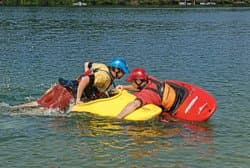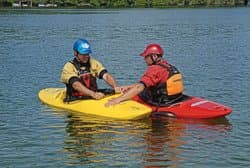Group Rescue: Aided Re-entry
Photos by Paul Villecourt
As a group leader or instructor, you often have a different relationship with the paddlers in your group than if you were with a bunch of similarly skilled friends. In this three part series, we're going to look at the basic rescue techniques that you'll likely find yourself having to perform.
On small rivers, the best option for rescuing swimmers is to get them to shore with all their equipment so that they can comfortably get themselves ready for the next round. In the calmer areas at the bottom of rapids on big-volume rivers, or when teaching on lakes, the shoreline can be a long way off. In these cases, you may be better off getting the swimmer back into his or her boat on the water. This is what we call an aided re-entry.
The first order of business is getting the water out of the kayak and flipping it upright. To do this, use the "boat-over-boat" technique. The boat-over-boat technique involves dragging the upside-down kayak over your own cockpit and then rocking the boat back and forth to dump the majority of the water out. Ideally, there are air bags in the back of the kayak that you are emptying. If there are, then it is easiest to pull the bow of that kayak over your own cockpit. If there aren't airbags in the kayak, then it won't matter which end of the kayak you start with, but with all the water in the upside-down kayak, you may need some help from the swimmer to get the boat pulled up onto your lap. In this case, the swimmer can help by pushing from the far end. Once you've emptied most of the water out, flip the kayak upright and bring it alongside your boat.


The next step involves the rescuer holding the kayak stationary as the swimmer climbs back in. To hold the boat steady, the rescuer should lie on the front deck of the empty kayak and hug it. The swimmer can approach the kayak from the stern, grab the cockpit rim, and pull him/herself up into a sitting position just behind the cockpit. The weight of the paddler on the back deck of the kayak will sink the stern and lift the bow into the air, so one of the rescuer's biggest jobs is to keep the bow down. For playboats, this can be very tricky. If the playboat is small enough and the paddler heavy enough, then it may not even be possible. Once the swimmer has reached the sitting position on the back of the cockpit rim, he should swing his legs into the boat and slide himself back in. At this point he'll probably need to sponge out any water left in his boat before snapping on his skirt, grabbing his paddle, and heading off. Ta-dah!

This is an excerpt from Ken Whiting's recently revised book,
'The Ultimate Guide to Whitewater Kayaking - 2nd Edition'
Ken is a World Champion Kayaker and the author and producer of an award winning series of instructional kayaking books and videos. He was recognized by "Paddler Magazine" as one of their 'Paddlers of the Century'. For more information, visit www.helipress.com.
Ken's book 'Rolling A Kayak' and latest DVD,'Recreational Kayaking: Essential Skills & Safety' are available in the Paddling.net Store! Along with his other popular DVD's like 'Ultimate Guide to Sea Kayaking'
Related Articles
Even though they are flipping over, missing their gates and failing their maneuvers, they still look…
Last month we discussed how to detect and patch (not "repair") a leak on a typical roto-molded kayak…
A kayaker should have a number of recovery methods to choose from in their bag of skills. I feel the…
There are two ways of swimming through a rapid. You can swim defensively or offensively. Defensive…


